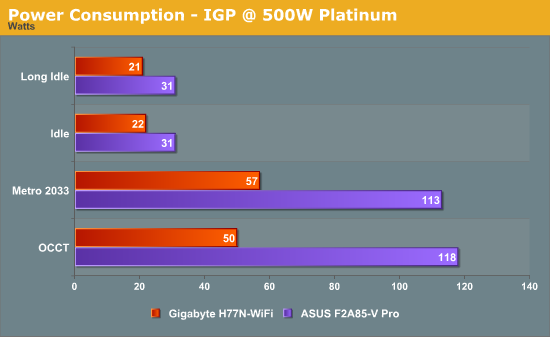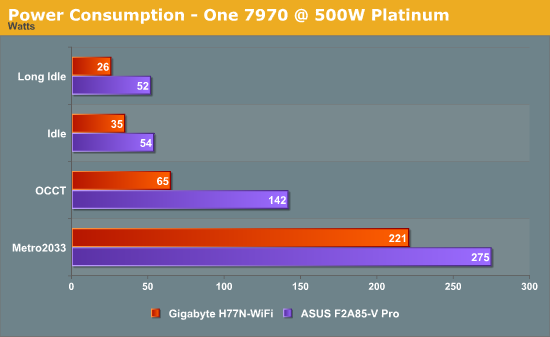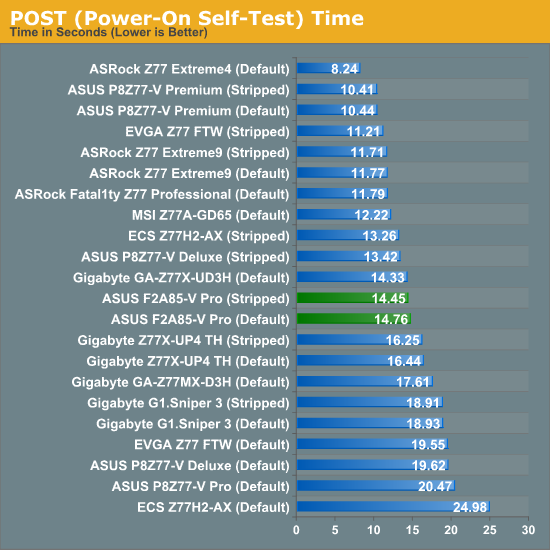ASUS F2A85-V Pro Review: A Look at FM2 with A85X
by Ian Cutress on October 10, 2012 11:20 AM EST- Posted in
- Motherboards
- Asus
- Trinity
- FM2
- A85X
Many thanks to...
We must thank the following companies for kindly donating hardware for our test bed:
OCZ for donating the Power Supply and USB testing SSD
Micron for donating our SATA testing SSD
G.Skill for donating our memory kits
ASUS for donating AMD GPUs and some IO testing kit
ECS for donating NVIDIA GPUs
Gigabyte for donating the i3-3225 used for comparison
Comparison of AMD Processors
On the following benchmarks, we will use results from comparible tests with previous processor families over the past 18 months. For AMD, this means we can compare the new Piledriver modules to Llano with its Stars cores, Phenom II and Thuban, and Zambezi with Bulldozer. The following processors are ones we have a variety of results for:
A6-3650 (32nm, 2.6 GHz) – Llano, 4 Stars cores
A8-3850 (32nm, 2.9 GHz) – Llano, 4 Stars cores
X6 1100T (45nm, 3.7 GHz Turbo) – Phenom II, 6 Thuban cores
FX-8150 (32nm, 4.2 GHz Turbo) – Zambezi, 4 Bulldozer modules
A10-5800K (32nm, 4.2GHz) – Trinity, 2 Piledriver modules
On the Intel side, we have the following:
Core i7-3960X (32nm, 3.9 GHz Turbo) – Sandy Bridge-E, 6 cores / 12 threads
Core i7-3770K (22nm, 3.9 GHz Turbo) – Ivy Bridge, 4 cores / 8 threads
Core i5-2500K (32nm, 3.7 GHz Turbo) – Sandy bridge, 4 cores / 4 threads
Core i3-3225 (22nm, 3.3 GHz) – Ivy Bridge, 2 cores / 4 threads
The aim of AMD is to put the A10 square on the bow of the Core i3-3225. For comparison, the A10-5800K release price is $122, whereas the boxed version of the i3-3225 should be ~$144.
Test Setup
| Processor |
AMD Trinity A10-4800K APU 2 Modules, 4 Threads, 3.8 GHz (4.2 GHz Turbo) |
| Motherboards | ASUS F2A85-V Pro |
| Cooling | beQuiet DarkPro CPU Cooler |
| Power Supply |
OCZ 1250W Gold ZX Series Rosewill SilentNight 500W Platinum PSU |
| Memory | G.Skill TridentX 4x4 GB DDR3-2400 10-12-12 Kit |
| Memory Settings | XMP |
| Video Cards |
ASUS HD7970 3GB ECS GTX 580 1536MB |
| Video Drivers |
Catalyst 12.3 NVIDIA Drivers 296.10 WHQL |
| Hard Drive | Corsair Force GT 60 GB (CSSD-F60GBGT-BK) |
| Optical Drive | LG GH22NS50 |
| Case | Open Test Bed - DimasTech V2.5 Easy |
| Operating System | Windows 7 64-bit |
| SATA Testing | Micron RealSSD C300 256GB |
| USB 2/3 Testing | OCZ Vertex 3 240GB with SATA->USB Adaptor |
Our main Intel comparison system is a to-be-reviewed Gigabyte H77N-WiFi with a 65W dual core i3-3225 processor against the 100W A10-5800K.
Power Consumption
Power consumption was tested on the system as a whole with a wall meter connected to a Rosewill 500W 80PLUS Platinum SilentNight power supply. As I am in the UK on a 230-240 V supply this leads to ~75% efficiency at low loads, and 90%+ efficiency between 20% and 100% loading. This method of power reading allows us to compare the power management of the UEFI and the board to supply components with power under load, and includes typical PSU losses due to efficiency. These are the real world values that consumers may expect from a typical system (minus the monitor) using this motherboard.


From our internal results, testing with 1 GPU on the 500W Platinum and 1250W Gold gave similar power readouts (Idle/OCCT/Metro on 500W gave 54/142/275, on 1250W gave 59/148/280), which means the 1250W is still good for comparison on the system. However for IGP testing, it was important to use the 500W. Our main comparison is the i3-3225 dual core Intel system on the to-be-reviewed Gigabyte H77N-WiFi, though the wattage between the processors accounts for large differences under load. At idle the larger ATX F2A85-V Pro does consume more power – if we get an ITX FM2 system, this will be a better comparison to test.
POST Time
Different motherboards have different POST sequences before an operating system is initialized. A lot of this is dependent on the board itself, and POST boot time is determined by the controllers on board (and the sequence of how those extras are organized). As part of our testing, we are now going to look at the POST Boot Time - this is the time from pressing the ON button on the computer to when Windows starts loading. (We discount Windows loading as it is highly variable given Windows specific features.) These results are subject to human error, so please allow +/- 1 second in these results.

The F2A85-V Pro uses ASUS’ new CAP BIOS system, designed to aid in POST times across their motherboard range. It helps a little here, as normally for ATX boards POST times are in the 16+ second region – the CAP BIOS reduces this to just under 15 seconds.










66 Comments
View All Comments
andykins - Wednesday, October 10, 2012 - link
A 2500k fits into socket 1155, not 1156 - the latter is Nehalem I believe?Old_Fogie_Late_Bloomer - Wednesday, October 10, 2012 - link
Likewise, the features chart on the first page lists PCIe 3.0 slots...Trinity has PCIe 2.0...IanCutress - Wednesday, October 10, 2012 - link
Apologies - first one was a brain fart, second was carry over. Tables like that I have to write in HTML (via excel) then copy paste in. Somehow got a weird mishmash of the last review and the new one.Ian
Kevin G - Wednesday, October 10, 2012 - link
First page, second paragraph:"Thus if I purchase an i7-3960X today, I know that it will fit into Socket 2011 based motherboards - similarly with the i5-2500K, it will fit into Socket 1156 motherboards. "
The i5-2500K fits into socket 1155.
Anonymous Blowhard - Wednesday, October 10, 2012 - link
> This full sized ATX board is aiming for the enthusiast in the Trinity space> enthusiast in the Trinity space
> enthusiast
> Trinity
Nope
djshortsleeve - Wednesday, October 10, 2012 - link
Well, AMD fanboi enthusiast maybejust4U - Wednesday, October 10, 2012 - link
I am not AMD fanboi but I am a fan of new computer hardware. As such I tend to grab some of the latest stuff. The thing about AMD boards (that I've noticed) is to get something comparable from Intel your usually looking at 30-50 more. Their boards are feature rich at a lower premium.This board in particular, (and Gigabyte's alternative) is over priced. I'd say by 20 bucks. But it's new hardware, slight price premium.. I expect in coming months this board will be 110-120 and the CPU it's paired with will drop to in and around the same price.
CeriseCogburn - Saturday, October 13, 2012 - link
LOL - caught again, and still in public denial.The gaming benchmark page is a shame to the human race and all reporters worldwide, but that's how amd corpo pig pressure rolls.
medi01 - Sunday, October 14, 2012 - link
Do you at least get payed by Intel?Utterly stupid to post so much shit for them for free...
darcotech - Thursday, October 11, 2012 - link
I totally agree.I consider myself more leaning toward AMD,but Trinity has no place in enthusiast world.
It was made as low to medium all-in-one (cheap) solution and as such, it works great.
Why would anyone put mid-high end GPU with trinity is beyond my imagination.
Even if you say you start with Trinity, then add G-card doesn't hold the true, because your CPU performance will suffer.Better start with strong CPU (probably Intel) and basic graphics card, and then later add something much stronger.At the end,you will have strong system.
150USD for Trinity oriented motherboard is not overkill.It is plain stupid.